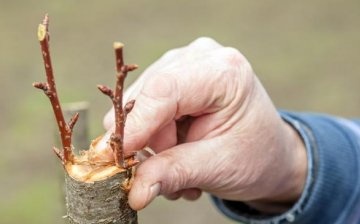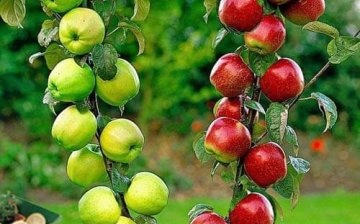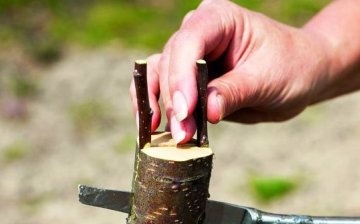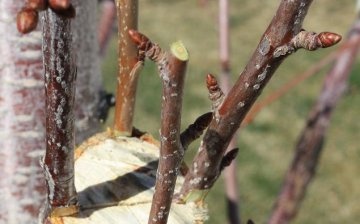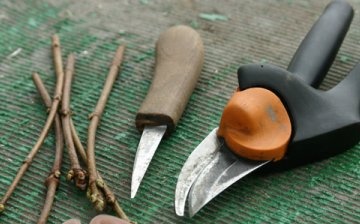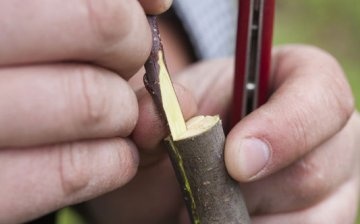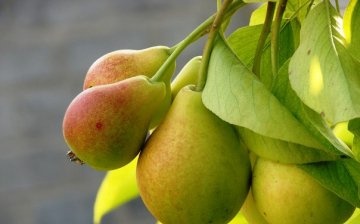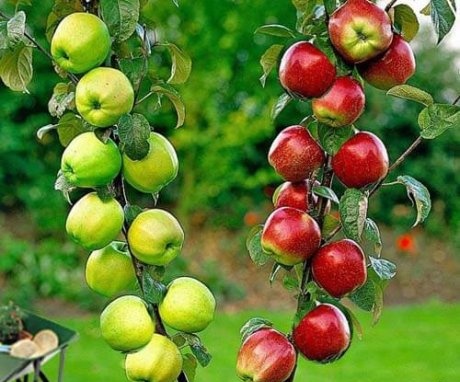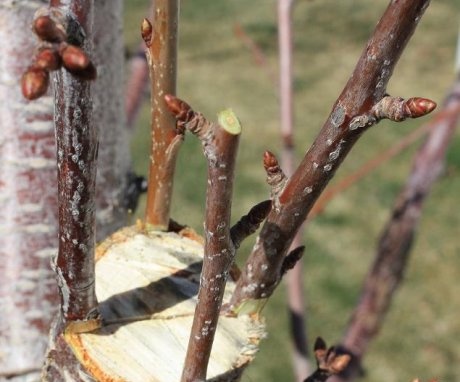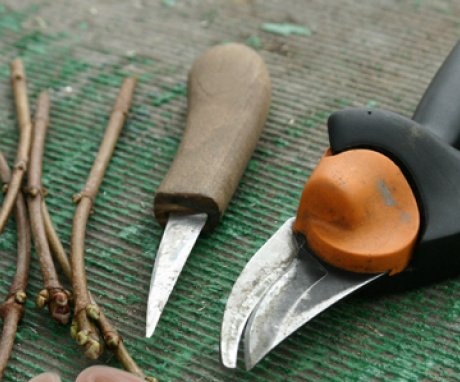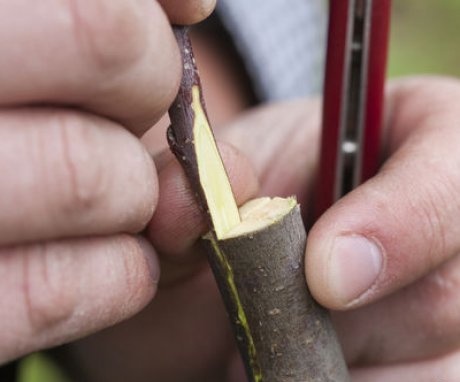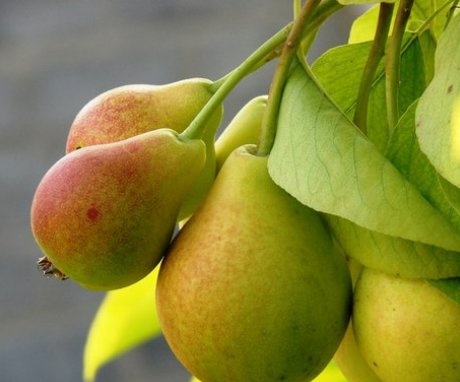Grafting and grafting of fruit trees - methods, rules and advantages
To improve the condition of their garden and increase yields, gardeners resort to various tricks, techniques for increasing the fruiting of trees. These methods include graft and re-grafting. Despite the seeming complexity, these procedures are quite simple and do not require professional skills. It is enough to know the rules and stages of this process and prepare all the necessary material.
Content:
- Vaccination and re-vaccination - what is it, goals and features
- Vaccination: benefits and types
- Other methods of vaccination
- Stages, rules of vaccination and necessary tools
- Re-vaccination: advantages, terms and rules of implementation
- How to properly care for fruit trees after grafting and re-grafting
Vaccination and re-vaccination - what is it, goals and features
The word "vaccination" is known to many from childhood as a medical procedure for protecting the body. In horticulture, grafting has a more direct meaning, but in a sense, it is also intended to improve the protective properties of the plant.
Graft and re-grafting of fruit trees consists in transferring part of one plant (bud or stalk) to another in order to improve the quality of the crop or the appearance of the tree. The two parts of the plant grow together and mutually influence each other.
Why do you need grafting trees? This procedure usually performs three tasks:
- Improve yields and get bigger fruits.
- Increase the protective properties of wood, improve its resistance to negative environmental influences.
- Improve the appearance of the plant, correct the crown, get rid of mechanical damage caused by bad weather or rodents.
Two compatible plants or one and the same are involved in the grafting. As a result, the plant is divided into two parts: the scion and rootstock... A graft is a stalk or bud, that part of a plant that joins a whole tree and takes root on it. As a rule, the scion is part of a tree that is no longer young and sufficiently productive. A stock is a plant (usually a young one), to which another part is grafted. Over time, all parts of the plant grow together and begin to have a beneficial effect on each other: the yield becomes larger, the fruits of higher quality, mechanical damage and wounds on the tree are actively tightened.
Only compatible plants can be grafted.
If these are plants of different species, then you can combine closely related ones: apple tree and pear, plum and cherry... You can get very interesting combinations of different fruits on the same tree. But when you try to plant pear and aspen, there will be no result. You can combine the same plant, improving its quality. For example, grow a seedling from a seed, take a stalk from it and graft it onto a mother plant. Thus, the tree acquires a different appearance, its condition will improve.
When re-grafting, a stalk with buds of a plant of a different variety is grown to a tree, which will bear the fruits of its own variety. Thus, you can grow on your site the desired variety, which for one reason or another is not adapted to growing in such conditions.
Vaccination: benefits and types
Benefits vaccinations trees in its accessibility and simplicity. Even an inexperienced gardener will be able to plant a tree if he carefully studies the material on this topic, finds the necessary tools and carefully observes the rules necessary for a successful result.
Sometimes grafting is the only way to keep a tree with the desired characteristics if it is in danger of dying from damage.
The advantages of this procedure include the speed of harvesting. If you grow the desired variety from the seed, the fruits will appear very slowly, it will take from 3 to 10 years. A grafted tree can bear fruit already in the second or third year after a successful vaccination.
There are 3 main and most commonly used types of grafting of fruit trees:
- Copulation. The simplest and most common type of grafting of trees, if both the rootstock and the scion are cut of the same diameter. All that needs to be done is to persuade the scion in advance, cut it and the stock with a sharp knife at an angle of about 30 degrees. Small splints are made on each cut, which will serve as a fastener. The two parts of the future plant are connected tightly and wrapped with tape. A plant grafted in this way recovers quickly.
- On the bark. A convenient method of grafting if the scion is much smaller than the stock. This option is good because it minimally traumatizes the grafted tree. Cuts and wounds heal quickly. The essence of this method is to make a small, neat cut in the bark of the stock and insert the cut stalk into it at an angle so that the bud looks at the stock.
- Into the cleft. Thus, it is convenient to graft old varieties of trees that you want to update. Only the central trunk should be left from the main tree (rootstock), carefully cutting off all skeletal branches. The trunk remains about half a meter high, no more. In the resulting hemp, holes (splits) are made no deeper than 5 cm, into which the cuttings will be inserted. In this way, you can inoculate several cuttings from different sides. They are inserted into the stump like wedges and wrapped with tape. Desirable process all cuts with garden pitch.
These are not all vaccinations, but these three are the most popular due to their simplicity and affordability.
Other methods of vaccination
There are other ways of grafting trees. They have their own subtleties. It should be remembered that with any chosen method, it is important to connect the two sections in such a way that the cambium is tightly connected. Cambium is the layer of active cells in wood. It is closer to the bark than to the core. The cambium layer is yellowish. When cutting, it is exposed and pressed tightly against the cambium of another part of the grafted plant.
- Side cut grafting. With this method of grafting, not only the bark is cut off, but also the entire thickness of the stock by about a third. It turns out a small beveled groove in the trunk. In this case, the shank is cut like a wedge and inserted into the recess. You need to insert it carefully and in such a way that the cambium layers are in close contact with each other. Then a bandage is applied along the entire length of the cut in a spiral. The attachment point can be treated with garden varnish.
- Saddle grafting on the bark. For this method of grafting, you need to leave a small stump of the stock, cutting off all the side branches. Then part of the bark is removed from the side along the hemp. You need to cut off a wedge-shaped area of no more than 2.5 cm. A small area is left from the cutting so that two buds remain on it. Anything below that needs to be cut in such a way that a "shoulder" with a beveled end is formed.The shoulder is connected to the cut on the rootstock in the only convenient way, that is, so that the angle of the shoulder rests against the hemp cut. Then a tight bandage is applied, and the wounds are treated with garden varnish.
- Inoculation. A simple and quite economical method of grafting, since instead of the entire cutting, only a few eyes are required. The eyes or buds are not removed from the cutting separately, but together with the adjacent tissues, that is, with a section of the bark. A T-shaped incision is made on the bark of the stock. A section of the bark of the scion with an eye is carefully inserted into it. The edges of the cortex are carefully fixed with tape so that the kidney itself remains in the air. After a while, a leaf will begin to form on it, and then a new shoot.
Any of the methods chosen will require precision action, sharpened tools and a carefully selected scion. Most often, the success of the procedure depends on the scion. It is worth remembering the timing of the vaccination. As a rule, a successful vaccination is carried out in the spring.
Stages, rules of vaccination and necessary tools
Before starting the vaccination, you need to prepare the scion and tools. It is better to cook the graft in the fall (if the graft is in the spring). It is not recommended to use a newly cut stalk. All instruments must be sharp. Do not cut branches with a blunt instrument. If large branches need to be removed, this is done with a hacksaw. Thinner, younger branches are cut with a sharp garden knife.
You need to cut off the buds and bark with a copulating knife of a special shape with a small protrusion at the end.
After preparing all the tools and the scion, the vaccination procedure can begin. It is held in the spring, it is advisable to choose a slightly hot and sunny day for this. Better to work in the morning. With any method of grafting, the steps are approximately the same: prepare a cut of the scion, prepare the stock, carefully connect all these parts of the plant and secure with tape.
There are some rules for grafting trees that beginner gardeners should know:
- Grafts must be prepared in advance. For this, a healthy shoot with large buds is chosen. It is stored completely and then cut into small cuttings... It is necessary to cut off such shoots before or after the end of sap flow. It is best to harvest them in the fall if the vaccination is scheduled for the spring. During the winter, you can weed out weak and frozen cuttings.
- You cannot use cuttings that have just been cut. They most often do not take root when vaccinated.
- In order for the grafting procedure to be successful, the yield becomes better, it is necessary to carefully approach the choice of the scion. Trees or seedlings from which cuttings will be cut must be healthy, fruitful, not affected by rodents and diseases... Usually those shoots that are on the sunny side of the tree are cut off.
- For best results, you should choose related trees. Trees that are too young should not be planted. This procedure is necessary to rejuvenate the plant. The stock must be at least 3 years old.
- A rootstock older than 10 years or with multiple stem damage is not suitable for grafting. Chances are good that the scion will not take root on such a tree.
- Do not vaccinate in the cold (winter and late autumn). Severe frosts can damage the cutting before it grows together with the stock, then the grafting will not bring the desired result.
Re-vaccination: advantages, terms and rules of implementation
Re-grafting is called changing the variety of an already mature tree with the help of a scion of a different variety. Re-vaccination often helps gardeners who have purchased and planted a fruit tree in their area that did not turn out to be as expected. For example, the variety of the tree does not match the description, the fruits are not tasty, or there are too few of them. In this case, re-grafting will be the best option, since uprooting and landing a new tree will take more time and effort, and the harvest can only be obtained in 5, or even more years.
It is recommended to re-inoculate not too old trees (up to 10 years for pome fruits, up to 6 years for stone fruits).
Older trees are not used as a rootstock, since cuttings rarely take root. The stages of grafting do not differ from the stages of grafting: preparation of the scion, the grafting process itself and caring for the grafted plant.
Re-grafting Tips:
- Re-vaccination is usually carried out in the spring, late March or early April. At this time, there are no longer severe frosts, and the process of sap flow has not yet begun. It is not forbidden to carry out re-grafting at a later date, for example, in May, during the period of the beginning of sap flow. But in this case, the methods of grafting will be different.
- You can plant a tree with a bud or eye even in June-August. Such re-grafting can give a good result. If you plan to renew the entire crown of a tree, re-grafting is carried out for two years in a row. The first year, one part of the tree is grafted, and the second - the other. It is not recommended to vaccinate both sides at once. After such a procedure, the plant needs to be given rest.
- Do not choose thick branches with a small number of buds as a scion. It is best to choose healthy annual shoots.
- It is advisable to prepare the scion in advance, in the fall. The desired varieties of shoots are selected and stored in cool rooms, cellars or basements. Sprinkle the lower parts of the cuttings with wet sand. Sometimes it is even recommended to just drop the cuttings on the site in a shaded place and leave it for the winter. But this must be done after the onset of frost, otherwise the cuttings can rot.
- The buds on the scion should not germinate until after the graft, so it is important to keep them cool. For the best storage places of cuts can be process garden pitch.
How to properly care for fruit trees after grafting and re-grafting
If the grafting or re-grafting procedure is carried out according to all the rules, after a few weeks the grafted tree will begin to germinate shoots from the buds of the scion. During this period, good care and protecting the plant from diseases and pests:
- The newly established scion, like the whole tree as a whole, should be protected from aphids and rodents, if necessary, treated drugsthat increase the protective functions of the plant.
- For the graft to be effective, the graft must have enough nutrients to grow. For this purpose, all shoots and branches that grow on the rootstock below the grafting levels are removed. This should be done all season, even after the scion has taken root. Thus, enough substances and moisture will flow from the roots to the graft so that it can successfully grow and bear fruit in the future.
- If the bark was cut during the grafting, you should monitor how the wound is tightened. It is advisable to process it several times with garden var.
- A newly grafted tree should be well watered, flooding the soil around the trunk so that the soil is saturated by about 30 cm. feeding.
- If several cuttings were grafted at once, all of them do not leave them. Only the strongest and most developed remains, the rest are first pruned, and then completely removed. One more cutting can be grafted only next year. All additional scions should be no more than 18 cm in length.
- The grafted cuttings are rather weak at first. They need to be protected from damage and strong winds. To prevent the birds and the wind from bending and breaking the scion, it is carefully tied to the support. It is better to leave the support until next year, but if you wish, you can remove it by the end of summer, since the young shoots should already be strong enough by this time.
- The garter must be carefully monitored and loosened as it grows so that it does not squeeze or injure the stalk. A year later, in the spring, the scion should be shortened by about a third.
- Experienced gardeners recommend covering the areas in the tree around the grafting with parchment paper.This will protect fresh wounds from the sun and hot air, which will speed up healing.
More useful information can be found in the video.



